ConnectiCon 2013: The Panels
Media analysis abounds at this "massively multi-genre convention"
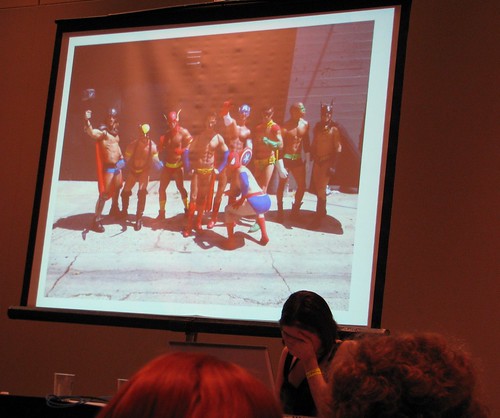 After attending panel after panel with pen in one hand, notebook in the other, and voice recorder in lap, I, the indomitable (indelible?) Ink, bring you my takes on the best* of what ConnectiCon 2013 programming had to offer. Each review is one part summary, one part impression, and nine parts sass (I kid). So take a scroll down after the break to read about panel programming that might be worth attending should it pop up at a con near you. Heck, some of the descriptions might inspire you to start your own panel of similar or original content!
After attending panel after panel with pen in one hand, notebook in the other, and voice recorder in lap, I, the indomitable (indelible?) Ink, bring you my takes on the best* of what ConnectiCon 2013 programming had to offer. Each review is one part summary, one part impression, and nine parts sass (I kid). So take a scroll down after the break to read about panel programming that might be worth attending should it pop up at a con near you. Heck, some of the descriptions might inspire you to start your own panel of similar or original content!
*Best of what I could get into, actually. I could not attend some panels that I wanted to due to room capacity issues.
 Overview of Japanese Handcrafts
Overview of Japanese Handcrafts
Registration lines made me slightly late for this panel, but its show-and-tell, led by Joanne, seemed a sort of perfect introduction to the con. From behind a table adorned with various types of handcrafts, the panelist explained slide after slide of examples of origami (paper folding), sashiko (“little stab” quilting), shibori (tie-dye), and so much more. Each form was accompanied by a brief history of the craft as well as intricate explanations of how the end products came to be (followed by elaboration upon divergent forms). Notably, all referenced art was cited in the slideshow, nice and large and center stage, with artists’ names and websites.
 Tortured Artist: Portrait of Hideaki Anno
Tortured Artist: Portrait of Hideaki Anno
The measure of a panel can be said to be its takeaway — what the listener has learned and internalized. A career retrospective and psychoanalysis such as this one, as given by Scott Spaziani, can prove most efficacious during chats with fans; I proved as much by pulling a theory purposed during the panel to enlighten fellow anime ruminators one post-con, beer-blurred night. Smudging the lines between using the director’s life to showcase the influence on his works and vice-versa, Spaziani held up the analytical mirror to the ways in which Anno’s life imitates his art imitating his life imitating … well, you get the idea. Anno’s biography was used to reference the ups and downs that exemplified the experiences which defined torture for this artist, shedding light onto not only the effects that can be seen onscreen but Anno’s absences therefrom as well.
Cartoon Themes from Around the World
A novel break from the usual OP/ED panel, this presentation simply and humorously proffered American animation openings as translated by various nations around the globe. The main enlightenment — that Warner Bros. evidently makes sure its themes’ cadences and melodies are adhered to during translation — came to bludgeon patience, however, as the Animaniacs theme rolled for the umpteenth time. If it wasn’t the OP that was overused, it was the language; panelists Neito and Yuyuke seemed to prefer Finnish because of its just-off similarity to English. Many more languages were included: Arabic, Hebrew, German, Japanese, French, and Russian, but dissimilarity seems the key to humor in this type of panel, and there was far too little of it for an hour’s worth of repetition for my taste. Watching several My Little Pony: Friendship is Magic songs didn’t help.
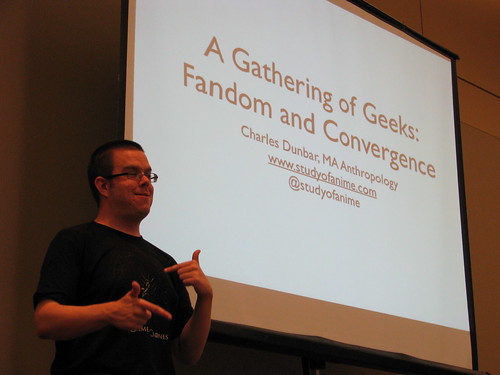 A Gathering of Geeks: Fandom and Convergence
A Gathering of Geeks: Fandom and Convergence
Charles Dunbar overlaid Henry Jenkins’ Convergence Culture: Where Old and New Media Collide onto fandom, specifically anime convention culture. As a multi-fandom convention, ConnectiCon seemed the perfect place for this panel, which examines culture shifts in con culture — how it has changed and is changing regarding attendee motivations and con activities. The punch of this panel came from the parallel between anime cons being birthed from sci-fi cons and, likewise, anime cons as both incubation chambers for other shared fandoms (My Little Pony) or hosts for independent fandoms (Homestuck). Themes explored included community expression, roles within community, convention policies and mission statements, and how people identify therewith. Entirely within his element, anthropologist Dunbar encouraged an enthusiastic and interactive session that led the audience to not so much a conclusion as a perpetual means of self-examination.
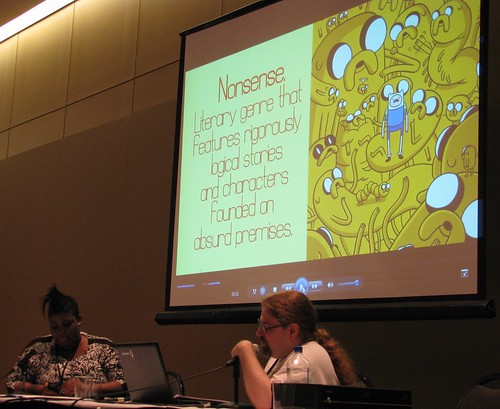 Reading Too Much into Adventure Time!
Reading Too Much into Adventure Time!
Starting with a rundown on nonsense literature, this panel, led by Froborr and Viga, traced Adventure Time’s evolution from meme machine to postmodern commentary through the show’s use of world building, characters, and their relationships. An adept and thorough overview of each of the aforementioned aspects, while perhaps initially humorous from an outsider’s point of view, proved that analysis conquers all! …or at least that analysis can give just about anything plausibility given the degree of work put into the argument by the analyst(s). Both panelists were detailed and entertaining with regards to their hypothesis, but the fun started during the Q&A. Audience members started posing theories that fit into the panelists’ framework, and the reaction from fans throughout the room was comically dramatic. This was a delightful panel with which to deepen appreciation of the show while still having fun.
Geekdom Feminism
While I made light of the fact that his panel was scheduled opposite a panel dedicated to “friendzoning,” it was legitimately heartening that this panel was over capacity from the get-go, while the other panel had numerous vacancies. That said, panelists Emily and Judith started off with a gentle, almost placating definition of feminism to dispel common misconceptions and set a very congenial tone for the panel (the fact that feminists have to adopt this meek attitude in order to be taken seriously in public forums often makes me violently ill). With that quickly out of the way, the focus was put on geekdom by examining talking points poignant to film, comic, videogame, and anime industries over the past few years, because as one panelist put it, “Both progress and how far we have to go are so very well expressed by our media.” The panelists’ takes on looking critically at media were spot on, but I took minor issue when they brought out statistics. Those that they cited seemed weighted seeing as examples only applied to a single year. Now I don’t doubt that year is (sadly) any less representative of an average, but statistics of an average across multiple years would be more effective and offer less reason for argument. Apologies for the lack of a representative photo, I was so engrossed in the panel I forgot to take one!
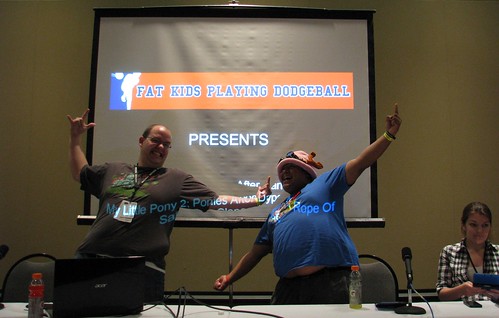 MLP 2; Ponies After Dark; A Rope of Sand; The Clopocalypse
MLP 2; Ponies After Dark; A Rope of Sand; The Clopocalypse
Why, God, oh why was this the first 18+ panel I’ve ever managed to attend? So. Much. Pony. Ponies like you’ve NEVER wanted to see. Ponies like you’ve never imagined no matter your depth of depravity. And I have to say that I ended up crying from laughing so much. People who missed out due to ConnectiCon’s absurd policy of closing the 18+ wristband booths at 10pm (this was a 10:30 panel and consequently not well attended) truly missed out. Though it was to a select few, Fat Kids Playing Dodgeball presented a laugh literally every minute via either commentary or presentation of outrageous visuals. My favorite was the dramatic readings of MLP fanfic, which were open to audience participation, and the retelling of an ill-fated (and now Internet-famous) RPG session.
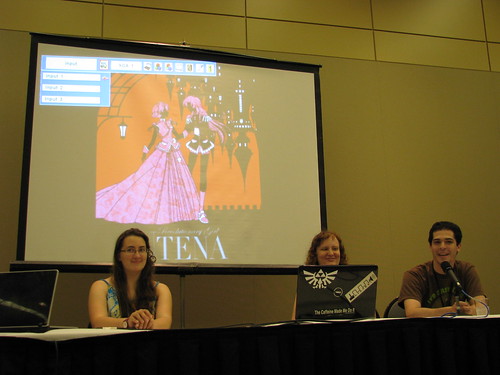 Revolutionary Girl Utena and Analyzing Anime
Revolutionary Girl Utena and Analyzing Anime
Anime can be analyzed? Who knew?! These three: Natalie, Judith, and Dan, who brought to the dissection table their respective field specialties of art analysis, animation experience, and script analysis. Together with the audience, the team defined and explored a number of different themes and symbols in Utena. Its characters were then put under the microscope, and from the posited traits, the panelists and audience alike put forth theories as to what each character represented individually as well as within the context of the series. The panelists also covered visual interpretations by presenting slides and guiding the audience, step-by-step but without any note of condescension, through the wealth of information to be found in each still image. This panel was a lot of fun if you, like me, love to dig into all that art can offer.
 Makoto Shinkai: The Next Myazaki?
Makoto Shinkai: The Next Myazaki?
In what amounted to substantially more than the troll that was its own conclusion, this panel, throughout its run, compared and contrasted the works of anime directors Hayao Miyazaki and Makoto Shinkai to gauge the talent of the latter against the former while taking into account such aspects as career paths, techniques, and focus. Praised content felt weighted in favor of Miyazaki, but moments in which its presenter, Scott Spaziani, went slack-jawed upon presentation of Shinkai’s works were notably more numerous and arresting. A goodly back-and-forth could be felt in the presentation, and although it existed as an argument between his own inner conflicts regarding the exhibited content, the tension exploited in Spaziani’s internal debate exposed much to ponder concerning these two great directors.
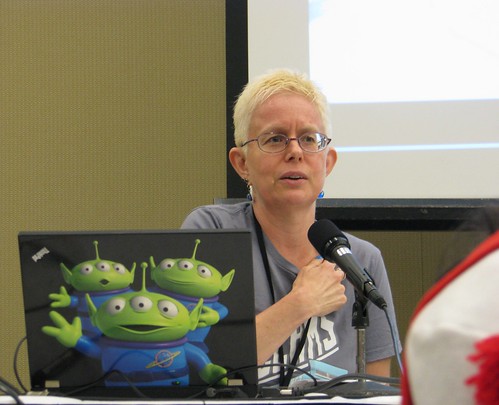 Every Pirate Loves His Mom: Depictions of Motherhood in Anime
Every Pirate Loves His Mom: Depictions of Motherhood in Anime
Laying down the law to begin the panel, Jennifer Teig von Hoffman, an anime fan interested in critical and literary analysis of pop culture, appeared strict but fair, firm but warm — motherly. This panel was her baby, and its construction was a labor of love … literally; the title came from a line in Castle in the Sky that was mutually misheard by the panelist and her son when they watched it together. A personal angle counts, especially in a panel exploring depictions of motherhood. Jennifer focused solely on what she considered fully developed mothers and did so in some novel ways. She examined motherhood as defined through relationships with others, looked at mothers defined by absence and sacrifice, and even analyzed how points of view lend to and can skew depictions of motherhood. The content was well thought out and organized, but there was definitely time to spare at the end of the panel for more. This is either commentary on how few fully realized mother characters there actually are out there in anime land or a call to watch more anime to find them.
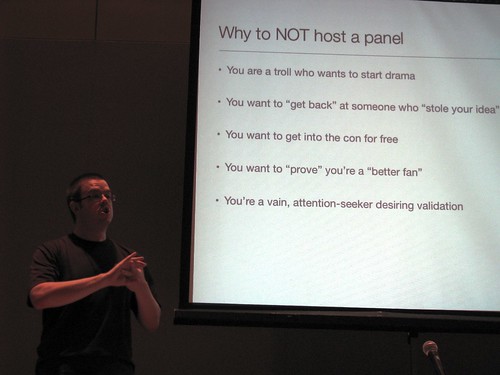 Panel Panel: A Panel on Panels
Panel Panel: A Panel on Panels
Ever wonder why Charles Dunbar panels usually have lines wrapping about the convention center at any given con? This was a chance to find out why in a very meta way. Dunbar defined various panel types and then outlined and explained his methods not only for creating and constructing panels but presenting them as well. A nice subtlety, whether intentional or not, was that, as opposed to his usually visually rich media content, there was but black text on a white screen backing up the points in his presentation. This meant that the way in which the panel’s vigor carried the audience’s attention was an unspoken example of certain aspects brought up during the course of the panel. When an expert on paneling speaks, it’s probably a good idea to listen. I know I came away with a couple of notes on what to do and not do with a panel I have in mind.
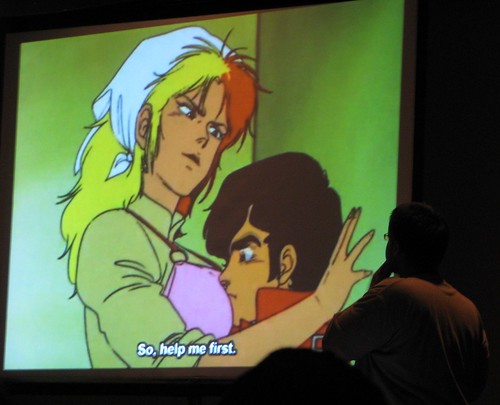 When Gundam Goes Bad
When Gundam Goes Bad
Gundam can be a divisive series in anime, but it has a huge fanbase which obsesses over the pilots, their gigantic robots, and the worlds they inhabit/protect/decimate. This panel, created by Scott “Gundam don’t have keys!!!” Spaziani, is brilliant in that it makes Gundam immediately accessible to all by allowing fans to laugh at themselves and the shows they love (and love to hate) while allowing critics to sit back and laugh at pretty much everything and everyone. Spaziani was obviously in his element here, appearing over the course of his presentation equal parts snarky and beaten and therefore ultimately ironically humorous. This worked to great effect. Even in some of the drier instances of bad, watching the panelist cry was entertainment enough.
Are you Scared? A Look at International Horror Films
There was no colon in the title, but rest assured, this was a Charles Dunbar (and Aleks) panel. How could you tell? Besides the fact that he was one half of the presenting team, in a word: content. For an 18+ panel at the end of the second day of a con, I honestly expected (and was geared for) a simple gore/horror clip fest. What ended up being presented was a breakdown of horror film elements specific to certain regions/countries, commentaries thereon, and a defining clip. No one could possibly fault the flow or content, which seemed like well-structured mini essays on boo flicks, but what made this panel drag a bit for me were the constant, time-sucking suggestions of other movies from the crowd. Then again, I came for the clips; the education was a bonus. Kudos must also be given for the “horror-ble” pun in the panel description in the con guidebook.
 Violence in Video Games: Not All Headshots are Equal
Violence in Video Games: Not All Headshots are Equal
Ajay Chaudhary and Dave Riley, also responsible for Otakon 2012’s knockout “Video Games as Literature: Approaching a New Criticism” panel, explored in this panel the various ways in which violence can be (mis)used in video games. Examples included simple lazy mechanics and empty motivation as well as opportunities that created depth from a field populated by otherwise vacuous narratives. Each section was extremely solid, and the banter between the panelists proved just as enlightening as the panel content itself. One of my favorite insights during the panel pertained to normative violence (“not bumping into each other”), specifically regarding information — attitudes towards race, gender, etc. — derived from the situational psychology of the game being played. I’ve said as much before, but panels that foster critical thinking about something usually taken for granted are golden, and this was a prime example.
 When Moe Goes Bad
When Moe Goes Bad
Unlike Gundam, which is pretty easy to describe, moé requires at the very least an introduction and a personal definition. Scott Spaziani was on point with both but stayed face-down in his iPad (or similar tablet) for most of the time while citing passages from Hiroki Azuma’s Database Animals. The intro thus felt long and dry for what seemed to promise a laugh-a-minute panel on moé being moé. When the clips started rolling, however, so did the eyes in the audience. Subsequent exposures to moé gone bad, as introduced and commented on by the confident Scott from “When Gundam Goes Bad,” elicited ever-louder belly laughs from the audience. But this was no mere laugh-fest. So long as attendees weren’t riddled with Ritalin, they should’ve noticed that the clips were actually exemplifying the points made during the earlier read-a-long. A good panel, but it needs to be either restructured to address the attention spans of all fans or the panelist needs to liven up that first half in some way; some pictures, perhaps, and livelier oration would not be wasted investments.
Click here for more coverage of ConnectiCon 2013.
